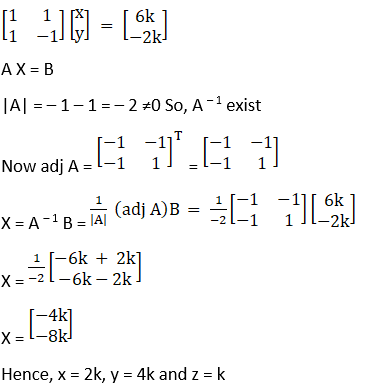Chapter 8 SOLUTIONS OF SIMULTANEOUS
Class 12th Maths R D Sharma Solution
Access answers to Maths RD Sharma Solutions For Class 12 Chapter 8 – Solution of Simultaneous Linear Equations
Exercise 8.1 Page No: 8.14
1. Solve the following system of equations by matrix method:
(i) 5x + 7y + 2 = 0
4x + 6y + 3 = 0
(ii) 5x + 2y = 3
3x + 2y = 5
(iii) 3x + 4y – 5 = 0
x – y + 3 = 0
(iv) 3x + y = 19
3x – y = 23
(v) 3x + 7y = 4
x + 2y = -1
(vi) 3x + y = 7
5x + 3y = 12
Solution:
(i) Given 5x + 7y + 2 = 0 and 4x + 6y + 3 = 0
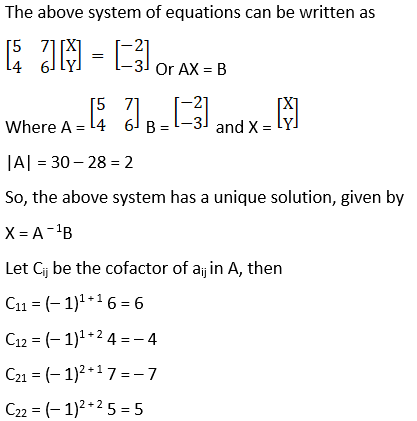
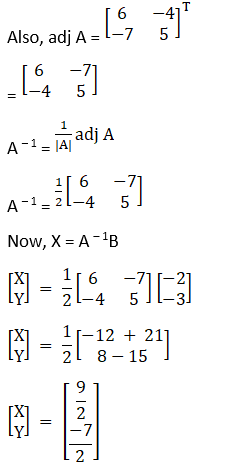
Hence, x = 9/2 and y = -7/2
(ii) Given 5x + 2y = 3
3x + 2y = 5
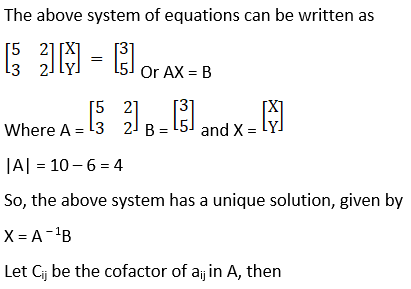

Hence, x = -1 and y = 4
(iii) Given 3x + 4y – 5 = 0
x – y + 3 = 0

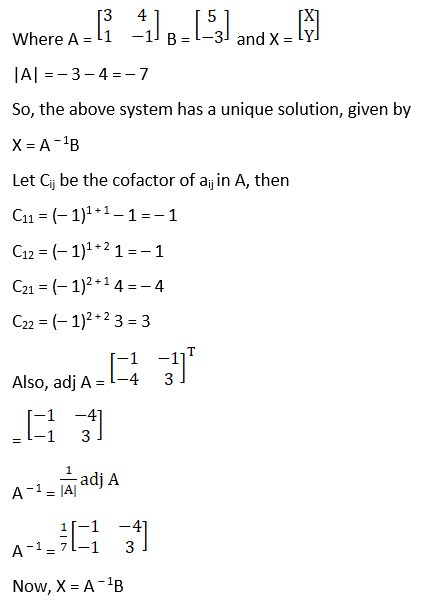
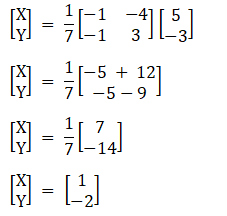
Hence, X = 1 Y = – 2
(iv) Given 3x + y = 19
3x – y = 23
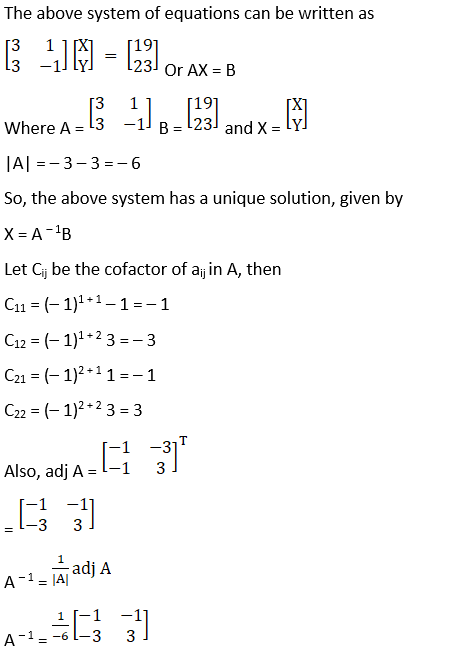
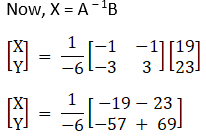
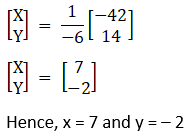
(v) Given 3x + 7y = 4
x + 2y = -1
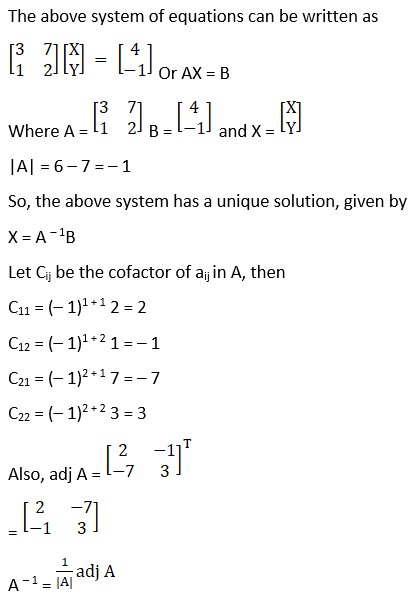
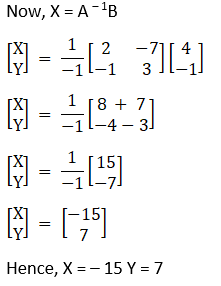
(vi) Given 3x + y = 7
5x + 3y = 12
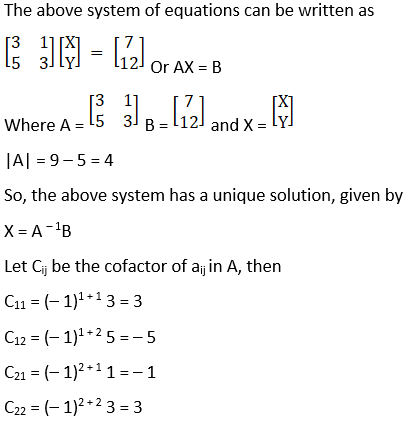
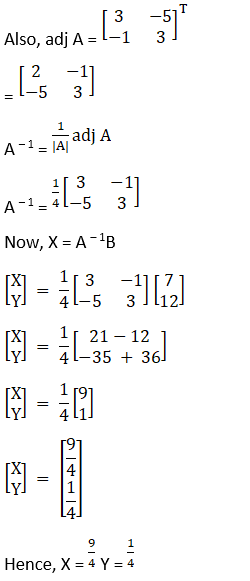
2. Solve the following system of equations by matrix method:
(i) x + y –z = 3
2x + 3y + z = 10
3x – y – 7z = 1
(ii) x + y + z = 3
2x – y + z = -1
2x + y – 3z = -9
(iii) 6x – 12y + 25z = 4
4x + 15y – 20z = 3
2x + 18y + 15z = 10
(iv) 3x + 4y + 7z = 14
2x – y + 3z = 4
x + 2y – 3z = 0
(v) (2/x) – (3/y) + (3/z) = 10
(1/x) + (1/y) + (1/z) = 10
(3/x) – (1/y) + (2/z) = 13
(vi) 5x + 3y + z = 16
2x + y + 3z = 19
x + 2y + 4z = 25
(vii) 3x + 4y + 2z = 8
2y – 3z = 3
x – 2y + 6z = -2
(viii) 2x + y + z = 2
x + 3y – z = 5
3x + y – 2z = 6
(ix) 2x + 6y = 2
3x – z = -8
2x – y + z = -3
(x) 2y – z = 1
x – y + z = 2
2x – y = 0
(xi) 8x + 4y + 3z = 18
2x + y + z = 5
x + 2y + z = 5
(xii) x + y + z = 6
x + 2z = 7
3x + y + z = 12
(xiii) (2/x) + (3/y) + (10/z) = 4,
(4/x) – (6/y) + (5/z) = 1,
(6/x) + (9/y) – (20/z) = 2, x, y, z ≠ 0
(xiv) x – y + 2z = 7
3x + 4y – 5z = -5
2x – y + 3z = 12
Solution:
(i) Given x + y –z = 3
2x + 3y + z = 10
3x – y – 7z = 1
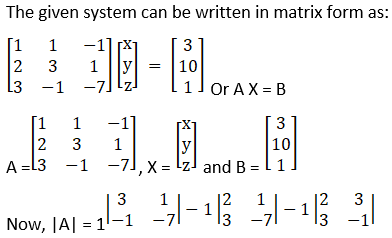
= (– 20) – 1(– 17) – 1(11)
= – 20 + 17 + 11 = 8
So, the above system has a unique solution, given by
X = A – 1B
Cofactors of A are
C11 = (– 1)1 + 1 – 21 + 1 = – 20
C21 = (– 1)2 + 1 – 7 – 1 = 8
C31 = (– 1)3 + 1 1 + 3 = 4
C12 = (– 1)1 + 2 – 14 – 3 = 17
C22 = (– 1)2 + 1 – 7 + 3 = – 4
C32 = (– 1)3 + 1 1 + 2 = – 3
C13 = (– 1)1 + 2 – 2 – 9 = – 11
C23 = (– 1)2 + 1 – 1 – 3 = 4
C33 = (– 1)3 + 1 3 – 2 = 1
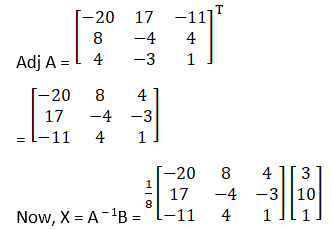
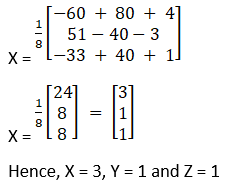
(ii) Given x + y + z = 3
2x – y + z = -1
2x + y – 3z = -9
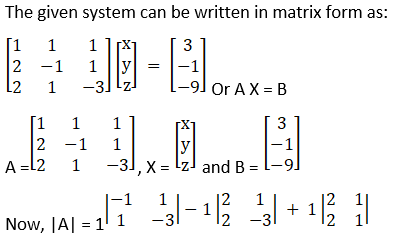
= (3 – 1) – 1(– 6 – 2) + 1(2 + 2)
= 2 + 8 + 4
= 14
So, the above system has a unique solution, given by
X = A – 1B
Cofactors of A are
C11 = (– 1)1 + 1 3 – 1 = 2
C21 = (– 1)2 + 1 – 3 – 1 = 4
C31 = (– 1)3 + 1 1 + 1 = 2
C12 = (– 1)1 + 2 – 6 – 2 = 8
C22 = (– 1)2 + 1 – 3 – 2 = – 5
C32 = (– 1)3 + 1 1 – 2 = 1
C13 = (– 1)1 + 2 2 + 2 = 4
C23 = (– 1)2 + 1 1 – 2 = 1
C33 = (– 1)3 + 1 – 1 – 2 = – 3
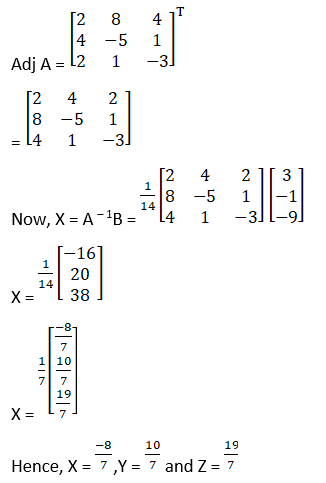
(iii) Given 6x – 12y + 25z = 4
4x + 15y – 20z = 3
2x + 18y + 15z = 10
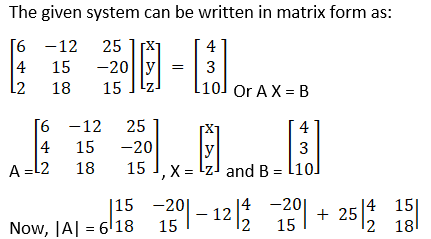
= 6(225 + 360) + 12(60 + 40) + 25(72 – 30)
= 3510 + 1200 + 1050
= 5760
So, the above system has a unique solution, given by
X = A – 1B
Cofactors of A are
C11 = (– 1)1 + 1 (225 + 360) = 585
C21 = (– 1)2 + 1 (– 180 – 450) = 630
C31 = (– 1)3 + 1 (240 – 375) = – 135
C12 = (– 1)1 + 2 (60 + 40) = – 100
C22 = (– 1)2 + 1 (90 – 50) = 40
C32 = (– 1)3 + 1 (– 120 – 100) = 220
C13 = (– 1)1 + 2 (72 – 30) = 42
C23 = (– 1)2 + 1(108 + 24) = – 132
C33 = (– 1)3 + 1 (90 + 48) = 138
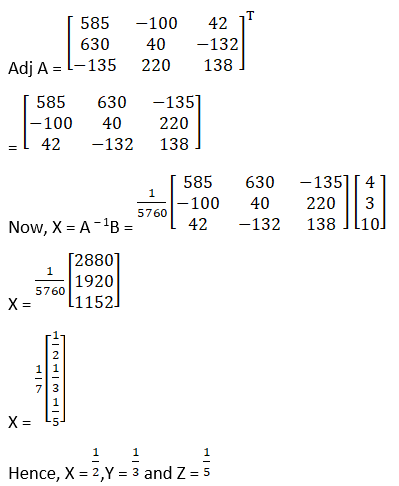
(iv) Given 3x + 4y + 7z = 14
2x – y + 3z = 4
x + 2y – 3z = 0
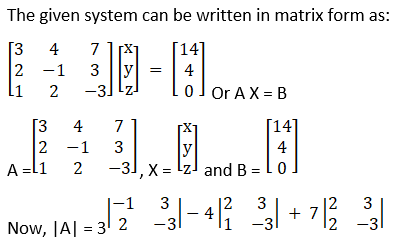
= 3(3 – 6) – 4(– 6 – 3) + 7(4 + 1)
= – 9 + 36 + 35
= 62
So, the above system has a unique solution, given by
X = A – 1B
Cofactors of A are
C11 = (– 1)1 + 1 3 – 6 = – 3
C21 = (– 1)2 + 1 – 12 – 14 = 26
C31 = (– 1)3 + 112 + 7 = 19
C12 = (– 1)1 + 2 – 6 – 3 = 9
C22 = (– 1)2 + 1 – 3 – 7 = – 10
C32 = (– 1)3 + 1 9 – 14 = 5
C13 = (– 1)1 + 2 4 + 1 = 5
C23 = (– 1)2 + 1 6 – 4 = – 2
C33 = (– 1)3 + 1 – 3 – 8 = – 11
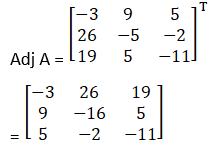
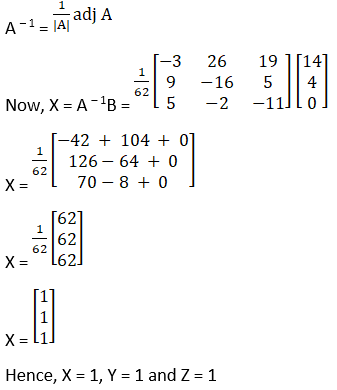
(v) Given (2/x) – (3/y) + (3/z) = 10
(1/x) + (1/y) + (1/z) = 10
(3/x) – (1/y) + (2/z) = 13
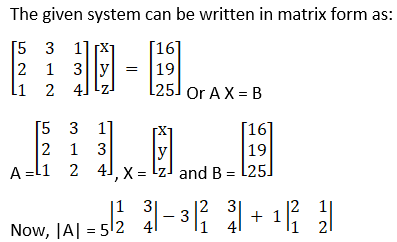
= 5(4 – 6) – 3(8 – 3) + 1(4 – 2)
= – 10 – 15 + 3
= – 22
So, the above system has a unique solution, given by
X = A – 1B
Cofactors of A are
C11 = (– 1)1 + 1 (4 – 6) = – 2
C21 = (– 1)2 + 1(12 – 2) = – 10
C31 = (– 1)3 + 1(9 – 1) = 8
C12 = (– 1)1 + 2 (8 – 3) = – 5
C22 = (– 1)2 + 1 20 – 1 = 19
C32 = (– 1)3 + 1 15 – 2 = – 13
C13 = (– 1)1 + 2 (4 – 2) = 2
C23 = (– 1)2 + 1 10 – 3 = – 7
C33 = (– 1)3 + 1 5 – 6 = – 1
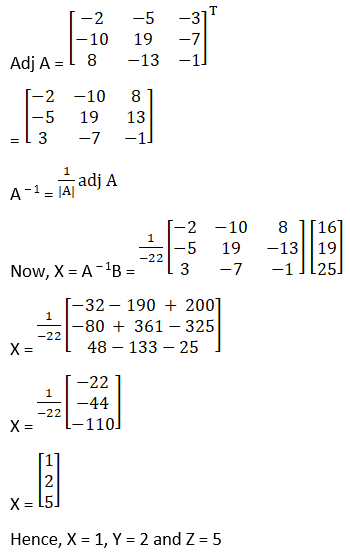
(vi) Given 5x + 3y + z = 16
2x + y + 3z = 19
x + 2y + 4z = 25
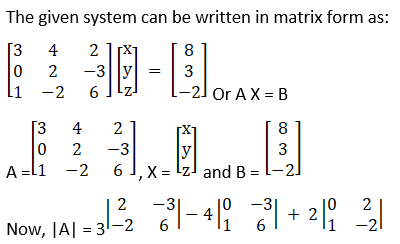
= 3(12 – 6) – 4(0 + 3) + 2(0 – 2)
= 18 – 12 – 4
= 2
So, the above system has a unique solution, given by
X = A – 1B
Cofactors of A are
C11 = (– 1)1 + 1 (12 – 6) = 6
C21 = (– 1)2 + 1(24 + 4) = – 28
C31 = (– 1)3 + 1(– 12 – 4) = – 16
C12 = (– 1)1 + 2 (0 + 3) = – 3
C22 = (– 1)2 + 1 18 – 2 = 16
C32 = (– 1)3 + 1 – 9 – 0 = 9
C13 = (– 1)1 + 2 (0 – 2) = – 2
C23 = (– 1)2 + 1 (– 6 – 4) = 10
C33 = (– 1)3 + 1 6 – 0 = 6
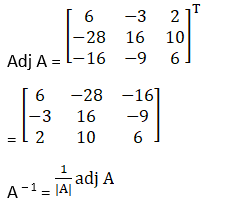
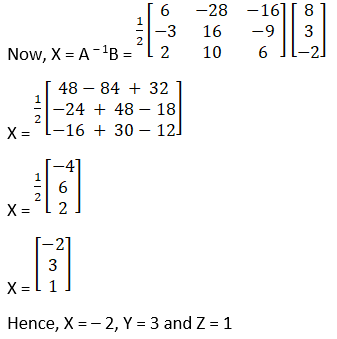
(vii) Given 3x + 4y + 2z = 8
2y – 3z = 3
x – 2y + 6z = -2
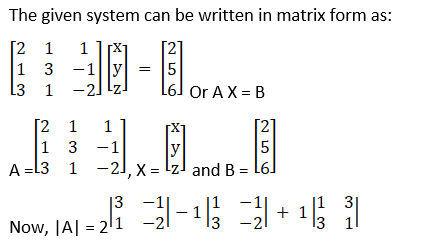
= 2(– 6 + 1) – 1(– 2 + 3) + 1(1 – 9)
= – 10 – 1 – 8
= – 19
So, the above system has a unique solution, given by
X = A – 1B
Cofactors of A are
C11 = (– 1)1 + 1 – 6 + 1 = – 5
C21 = (– 1)2 + 1(24 + 4) = – 28
C31 = (– 1)3 + 1 – 1 – 3 = – 4
C12 = (– 1)1 + 2 – 2 + 3 = – 1
C22 = (– 1)2 + 1 – 4 – 3 = – 7
C32 = (– 1)3 + 1 – 2 – 1 = 3
C13 = (– 1)1 + 21 – 9 = – 8
C23 = (– 1)2 + 12 – 3 = – 1
C33 = (– 1)3 + 1 6 – 1 = 5
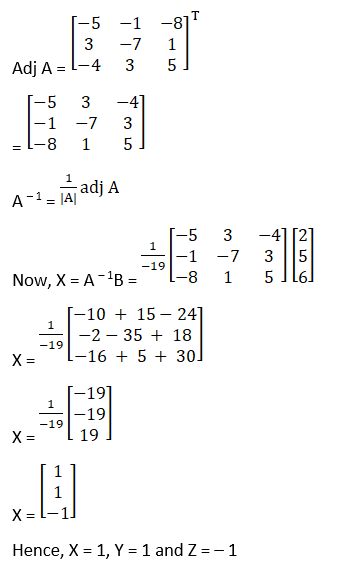
(viii) Given 2x + y + z = 2
x + 3y – z = 5
3x + y – 2z = 6
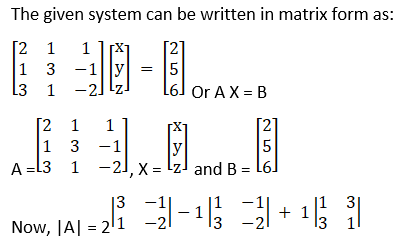
= 2(– 6 + 1) – 1(– 2 + 3) + 1(1 – 9)
= – 10 – 1 – 8
= – 19
So, the above system has a unique solution, given by
X = A – 1B
Cofactors of A are
C11 = (– 1)1 + 1 – 6 + 1 = – 5
C21 = (– 1)2 + 1(24 + 4) = – 28
C31 = (– 1)3 + 1 – 1 – 3 = – 4
C12 = (– 1)1 + 2 – 2 + 3 = – 1
C22 = (– 1)2 + 1 – 4 – 3 = – 7
C32 = (– 1)3 + 1 – 2 – 1 = 3
C13 = (– 1)1 + 21 – 9 = – 8
C23 = (– 1)2 + 12 – 3 = – 1
C33 = (– 1)3 + 1 6 – 1 = 5
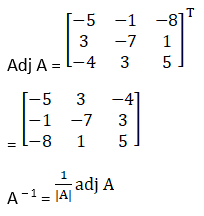
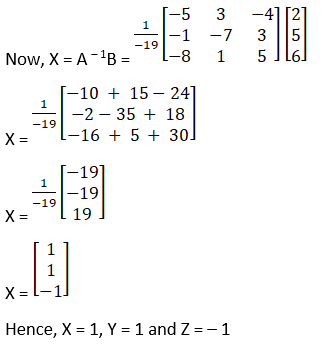
(ix) Given 2x + 6y = 2
3x – z = -8
2x – y + z = -3
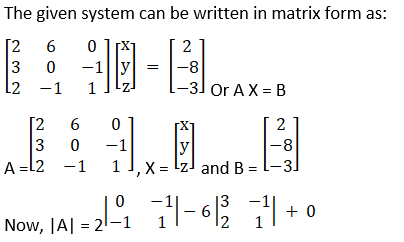
= 2(0 – 1) – 6(3 + 2)
= – 2 – 30
= – 32
So, the above system has a unique solution, given by
X = A – 1B
Cofactors of A are
C11 = (– 1)1 + 1 0 – 1 = – 1
C21 = (– 1)2 + 16 + 0 = – 6
C31 = (– 1)3 + 1 – 6 = – 6
C12 = (– 1)1 + 2 3 + 2 = 5
C22 = (– 1)2 + 1 2 – 0 = 2
C32 = (– 1)3 + 1 – 2 – 0 = 2
C13 = (– 1)1 + 2 – 3 – 0 = – 3
C23 = (– 1)2 + 1 – 2 – 12 = 14
C33 = (– 1)3 + 1 0 – 18 = – 18
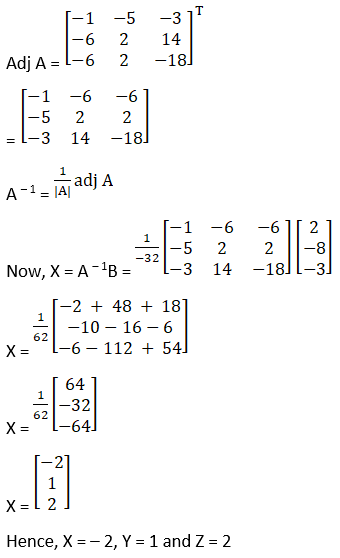
(x) Given 2y – z = 1
x – y + z = 2
2x – y = 0
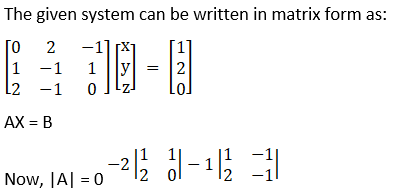
= 0 + 4 – 1
= 3
So, the above system has a unique solution, given by
X = A – 1B
Cofactors of A are
C11 = (– 1)1 + 1 1 – 0 = 1
C21 = (– 1)2 + 11 – 2 = 1
C31 = (– 1)3 + 10 + 1 = 1
C12 = (– 1)1 + 2 – 2 – 0 = 2
C22 = (– 1)2 + 1 – 1 – 0 = – 1
C32 = (– 1)3 + 1 0 – 2 = 2
C13 = (– 1)1 + 2 4 – 0 = 4
C23 = (– 1)2 + 1 2 – 0 = – 2
C33 = (– 1)3 + 1 – 1 + 2 = 1
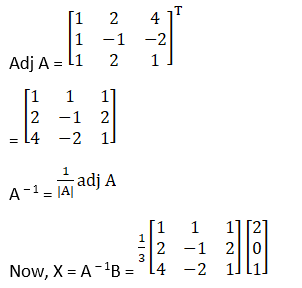
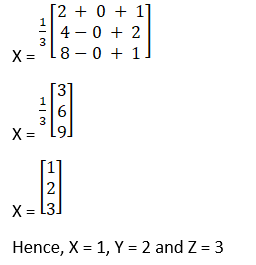
(xi) Given 8x + 4y + 3z = 18
2x + y + z = 5
x + 2y + z = 5
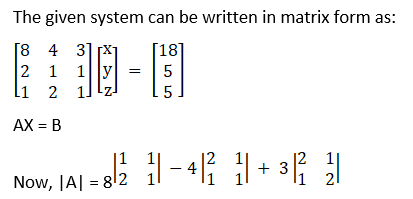
= 8(– 1) – 4(1) + 3(3)
= – 8 – 4 + 9
= – 3
So, the above system has a unique solution, given by
X = A – 1B
Cofactors of A are
C11 = (– 1)1 + 1 1 – 2 = – 1
C21 = (– 1)2 + 1 4 – 6 = 2
C31 = (– 1)3 + 1 4 – 3 = 1
C12 = (– 1)1 + 2 2 – 1 = – 1
C22 = (– 1)2 + 1 8 – 3 = 5
C32 = (– 1)3 + 1 8 – 6 = – 2
C13 = (– 1)1 + 2 4 – 1 = 3
C23 = (– 1)2 + 1 16 – 4 = – 12
C33 = (– 1)3 + 1 8 – 8 = 0
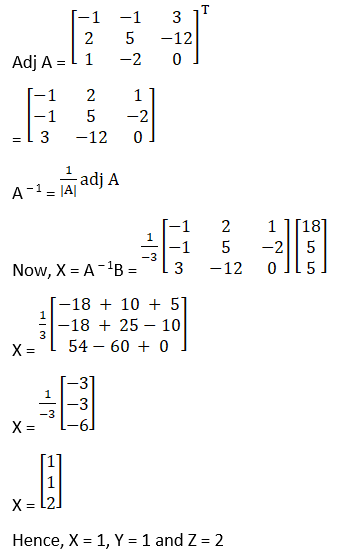
(xii) Given x + y + z = 6
x + 2z = 7
3x + y + z = 12


= 1(– 2) – 1(1 – 6) + 1(1)
= – 2 + 5 + 1
= 4
So, the above system has a unique solution, given by
X = A – 1B
Cofactors of A are
C11 = (– 1)1 + 1 0 – 2 = – 2
C21 = (– 1)2 + 1 1 – 1 = 0
C31 = (– 1)3 + 1 2 – 0 = 2
C12 = (– 1)1 + 2 1 – 6 = 5
C22 = (– 1)2 + 1 1 – 3 = – 2
C32 = (– 1)3 + 1 2 – 1 = – 1
C13 = (– 1)1 + 2 1 – 0 = 1
C23 = (– 1)2 + 1 1 – 3 = 2
C33 = (– 1)3 + 1 0 – 1 = – 1
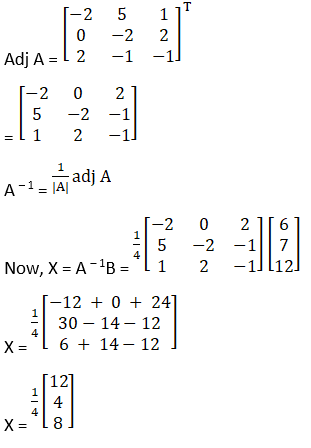
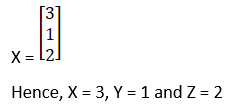
(xiii) Given (2/x) + (3/y) + (10/z) = 4,
(4/x) – (6/y) + (5/z) = 1,
(6/x) + (9/y) – (20/z) = 2, x, y, z ≠ 0

AX = B
Now,
|A| = 2(75) – 3(– 110) + 10(72)
= 150 + 330 + 720
= 1200
So, the above system has a unique solution, given by
X = A – 1B
Cofactors of A are
C11 = (– 1)1 + 1 120 – 45 = 75
C21 = (– 1)2 + 1 – 60 – 90 = 150
C31 = (– 1)3 + 1 15 + 60 = 75
C12 = (– 1)1 + 2 – 80 – 30 = 110
C22 = (– 1)2 + 1 – 40 – 60 = – 100
C32 = (– 1)3 + 1 10 – 40 = 30
C13 = (– 1)1 + 2 36 + 36 = 72
C23 = (– 1)2 + 1 18 – 18 = 0
C33 = (– 1)3 + 1 – 12 – 12 = – 24
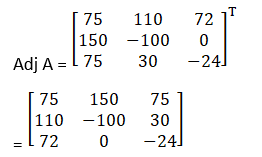
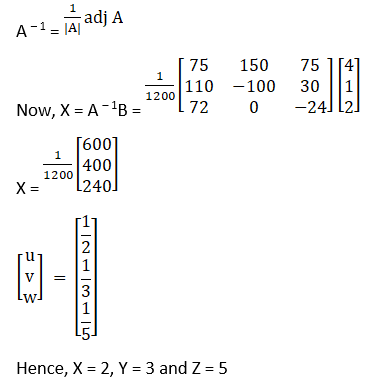
(xiv) Given x – y + 2z = 7
3x + 4y – 5z = -5
2x – y + 3z = 12

A X = B
Now,
|A| = 1(12 – 5) + 1(9 + 10) + 2(– 3 – 8)
= 7 + 19 – 22
= 4
So, the above system has a unique solution, given by
X = A – 1B
Cofactors of A are
C11 = (– 1)1 + 1 12 – 5 = 7
C21 = (– 1)2 + 1 – 3 + 2 = 1
C31 = (– 1)3 + 1 5 – 8 = – 3
C12 = (– 1)1 + 2 9 + 10 = – 19
C22 = (– 1)2 + 1 3 – 4 = – 1
C32 = (– 1)3 + 1 – 5 – 6 = 11
C13 = (– 1)1 + 2 – 3 – 8 = – 11
C23 = (– 1)2 + 1 – 1 + 2 = – 1
C33 = (– 1)3 + 1 4 + 3 = 7
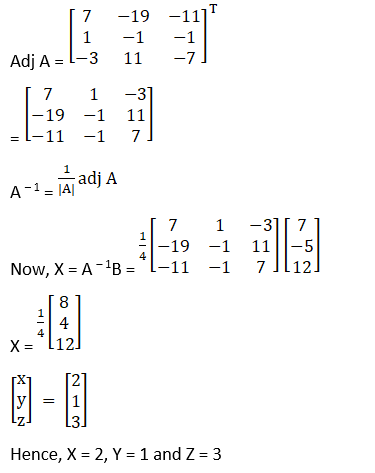
3. Show that each one of the following systems of linear equations is consistent and also find their solutions:
(i) 6x + 4y = 2
9x + 6y = 3
(ii) 2x + 3y = 5
6x + 9y = 15
(iii) 5x + 3y + 7z = 4
3x + 26y + 2z = 9
7x + 2y + 10z = 5
(v) x + y + z = 6
x + 2y + 3z = 14
x + 4y + 7z = 30
(vi) 2x + 2y – 2z = 1
4x + 4y – z = 2
6x + 6y + 2z = 3
Solution:
(i) Given 6x + 4y = 2
9x + 6y = 3
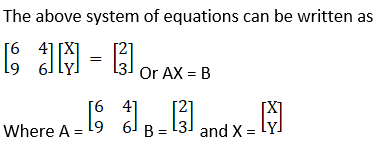
|A| = 36 – 36 = 0
So, A is singular, Now X will be consistence if (Adj A) x B = 0
C11 = (– 1)1 + 1 6 = 6
C12 = (– 1)1 + 2 9 = – 9
C21 = (– 1)2 + 1 4 = – 4
C22 = (– 1)2 + 2 6 = 6
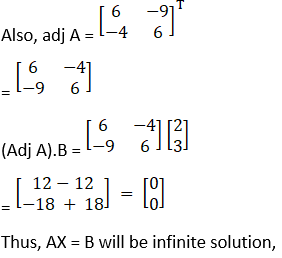
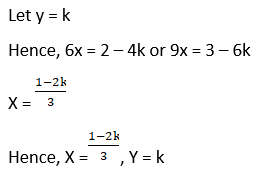
(ii) Given 2x + 3y = 5
6x + 9y = 15
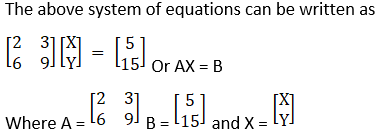
|A| = 18 – 18 = 0
So, A is singular,
Now X will be consistence if (Adj A) x B = 0
C11 = (– 1)1 + 1 9 = 9
C12 = (– 1)1 + 2 6 = – 6
C21 = (– 1)2 + 1 3 = – 3
C22 = (– 1)2 + 2 2 = 2
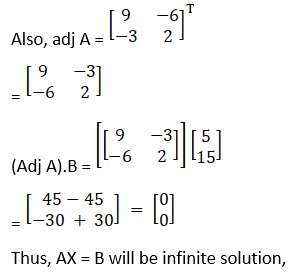
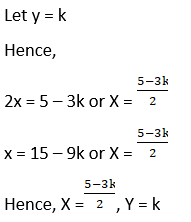
(iii) Given 5x + 3y + 7z = 4
3x + 26y + 2z = 9
7x + 2y + 10z = 5
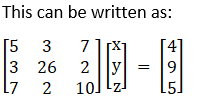
|A| = 5(260 – 4) – 3(30 – 14) + 7(6 – 182)
= 5(256) – 3(16) + 7(176)
|A| = 0
So, A is singular. Thus, the given system is either inconsistent or it is consistent with infinitely many solution according to as:
(Adj A) x B≠0 or (Adj A) x B = 0
Cofactors of A are
C11 = (– 1)1 + 1 260 – 4 = 256
C21 = (– 1)2 + 1 30 – 14 = – 16
C31 = (– 1)3 + 1 6 – 182 = – 176
C12 = (– 1)1 + 2 30 – 14 = – 16
C22 = (– 1)2 + 1 50 – 49 = 1
C32 = (– 1)3 + 1 10 – 21 = 11
C13 = (– 1)1 + 2 6 – 182 = – 176
C23 = (– 1)2 + 1 10 – 21 = 11
C33 = (– 1)3 + 1 130 – 9 = 121
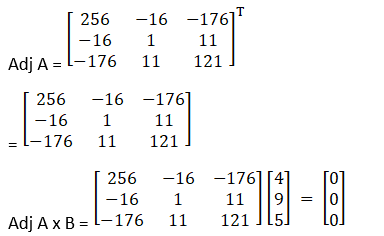
Now, AX = B has infinite many solution
Let z = k
Then, 5x + 3y = 4 – 7k
3x + 26y = 9 – 2k
This can be written as
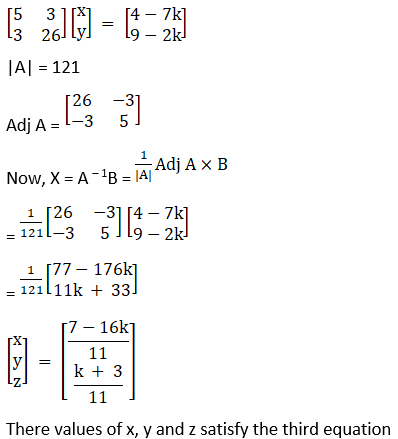
(v) Given x + y + z = 6
x + 2y + 3z = 14
x + 4y + 7z = 30
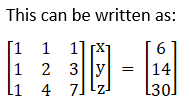
|A| = 1(2) – 1(4) + 1(2)
= 2 – 4 + 2
|A| = 0
So, A is singular. Thus, the given system is either inconsistent or it is consistent with infinitely many solution according to as:
(Adj A) x B≠0 or (Adj A) x B = 0
Cofactors of A are
C11 = (– 1)1 + 1 14 – 12 = 2
C21 = (– 1)2 + 1 7 – 4 = – 3
C31 = (– 1)3 + 1 3 – 2 = 1
C12 = (– 1)1 + 2 7 – 3 = – 4
C22 = (– 1)2 + 1 7 – 1 = 6
C32 = (– 1)3 + 1 3 – 1 = 2
C13 = (– 1)1 + 2 4 – 2 = 2
C23 = (– 1)2 + 1 4 – 1 = – 3
C33 = (– 1)3 + 1 2 – 1 = 1
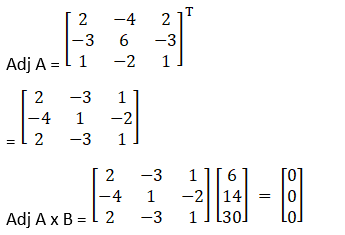
Now, AX = B has infinite many solution
Let z = k
Then, x + y = 6 – k
x + 2y = 14 – 3k
This can be written as:
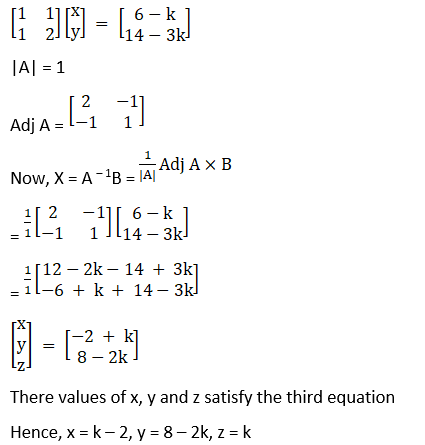
(vi) Given x + y + z = 6
x + 2y + 3z = 14
x + 4y + 7z = 30
This can be written as

|A| = 2(14) – 2(14) – 2(0)
|A| = 0
So, A is singular. Thus, the given system is either inconsistent or it is consistent
with infinitely many solution according to as:
(Adj A) x B≠0 or (Adj A) x B = 0
Cofactors of A are:
C11 = (– 1)1 + 18 + 6 = 14
C21 = (– 1)2 + 1 4 + 12 = – 16
C31 = (– 1)3 + 1 – 2 + 8 = 6
C12 = (– 1)1 + 2 8 + 6 = – 14
C22 = (– 1)2 + 1 4 + 12 = 16
C32 = (– 1)3 + 1 – 2 + 8 = – 6
C13 = (– 1)1 + 2 24 – 24 = 0
C23 = (– 1)2 + 1 12 – 12 = 0
C33 = (– 1)3 + 1 8 – 8 = 0
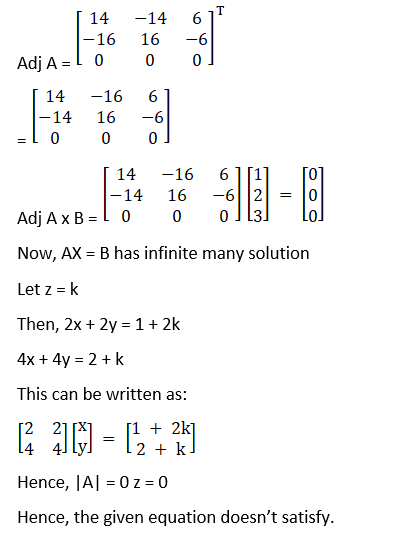
4. Show that each one of the following systems of linear equations is consistent:
(i) 2x + 5y = 7
6x + 15y = 13
(ii) 2x + 3y = 5
6x + 9y = 10
(iii) 4x – 2y = 3
6x – 3y = 5
(iv) 4x – 5y – 2z = 2
5x – 4y + 2z = -2
2x + 2y + 8z = -1
(v) 3x – y – 2z = 2
2y – z = -1
3x – 5y = 3
(vi) x + y – 2z = 5
x – 2y + z = -2
-2x + y + z = 4
Solution:
(i) Given 2x + 5y = 7
6x + 15y = 13
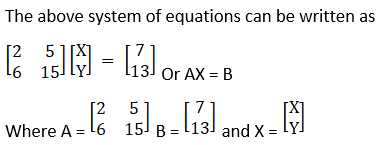
|A| = 30 – 30 = 0
So, A is singular,
Now X will be consistence if (Adj A) x B = 0
C11 = (– 1)1 + 1 15 = 15
C12 = (– 1)1 + 2 6 = – 6
C21 = (– 1)2 + 1 5 = – 5
C22 = (– 1)2 + 2 2 = 2
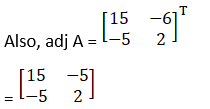
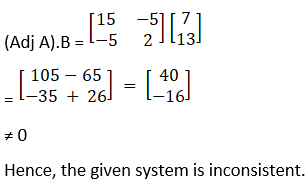
(ii) Given 2x + 3y = 5
6x + 9y = 10
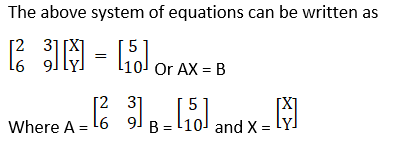
|A| = 18 – 18 = 0
So, A is singular,
Now X will be consistence if (Adj A) x B = 0
C11 = (– 1)1 + 1 9 = 9
C12 = (– 1)1 + 2 6 = – 6
C21 = (– 1)2 + 1 3 = – 3
C22 = (– 1)2 + 2 2 = 2
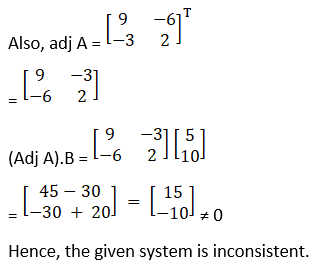
(iii) Given 4x – 2y = 3
6x – 3y = 5
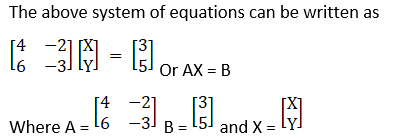
|A| = – 12 + 12 = 0
So, A is singular,
Now X will be consistence if (Adj A) x B = 0
C11 = (– 1)1 + 1 – 3 = – 3
C12 = (– 1)1 + 2 6 = – 6
C21 = (– 1)2 + 1 – 2 = 2
C22 = (– 1)2 + 2 4 = 4
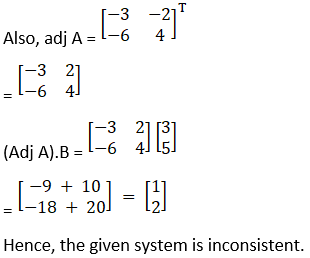
(iv) Given 4x – 5y – 2z = 2
5x – 4y + 2z = -2
2x + 2y + 8z = -1

|A| = 4(– 36) + 5(36) – 2(18)
|A| = 0
Cofactors of A are:
C11 = (– 1)1 + 1 – 32 – 4 = – 36
C21 = (– 1)2 + 1 – 40 + 4 = – 36
C31 = (– 1)3 + 1 – 10 – 8 = – 18
C12 = (– 1)1 + 2 40 – 4 = – 36
C22 = (– 1)2 + 1 32 + 4 = 36
C32 = (– 1)3 + 1 8 + 10 = – 18
C13 = (– 1)1 + 2 10 + 8 = 18
C23 = (– 1)2 + 1 8 + 10 = – 18
C33 = (– 1)3 + 1 – 16 + 25 = 9
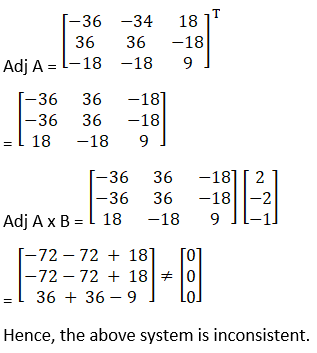
(v) Given 3x – y – 2z = 2
2y – z = -1
3x – 5y = 3

|A| = 3(– 5) + 1(3) – 2(– 6)
|A| = 0
Cofactors of A are
C11 = (– 1)1 + 1 0 – 5 = – 5
C21 = (– 1)2 + 1 0 – 10 = 10
C31 = (– 1)3 + 1 1 + 4 = 5
C12 = (– 1)1 + 2 0 + 3 = – 3
C22 = (– 1)2 + 1 0 + 6 = 6
C32 = (– 1)3 + 1 – 3 – 0 = 3
C13 = (– 1)1 + 2 0 – 6 = – 6
C23 = (– 1)2 + 1 – 15 + 3 = 12
C33 = (– 1)3 + 1 6 – 0 = 6
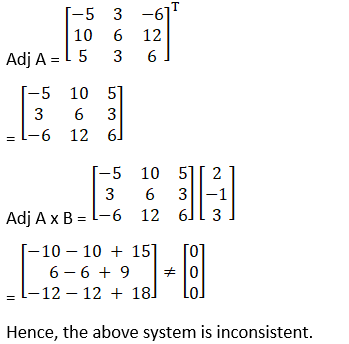
(vi) Given x + y – 2z = 5
x – 2y + z = -2
-2x + y + z = 4

|A| = 1(– 3) – 1(3) – 2(– 3) = – 3 – 3 + 6
|A| = 0
Cofactors of A are:
C11 = (– 1)1 + 1 – 2 – 1 = – 3
C21 = (– 1)2 + 1 1 + 2 = – 3
C31 = (– 1)3 + 1 1 – 4 = – 3
C12 = (– 1)1 + 2 1 + 2 = – 3
C22 = (– 1)2 + 1 1 – 4 = – 3
C32 = (– 1)3 + 1 1 + 2 = – 3
C13 = (– 1)1 + 2 1 – 4 = – 3
C23 = (– 1)2 + 1 1 + 2 = – 3
C33 = (– 1)3 + 1 – 2 – 1 = – 3
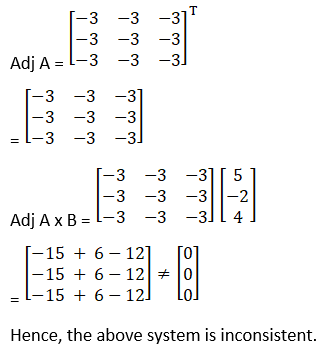

x – y = 3, 2x + 3y + 4z = 17, y + 2z = 7
Solution:
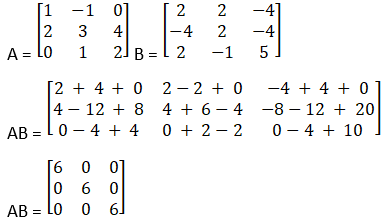
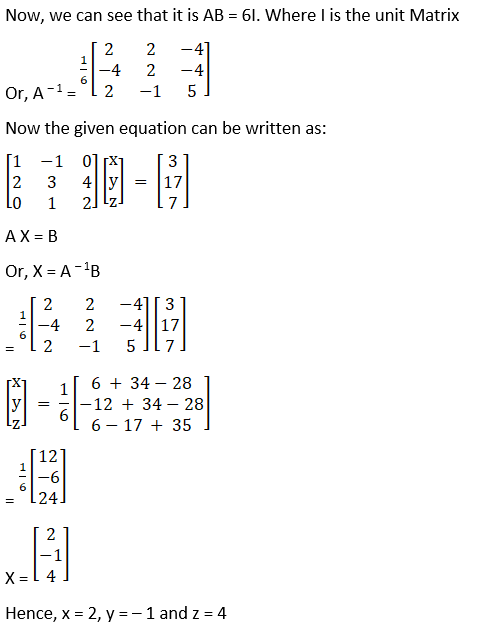

2x – 3y + 5z = 11, 3x + 2y – 4z = -5, x + y – 2z = -3.
Solution:

|A| = 2(0) + 3(– 2) + 5(1)
= – 1
Now, the cofactors of A
C11 = (– 1)1 + 1 – 4 + 4 = 0
C21 = (– 1)2 + 1 6 – 5 = – 1
C31 = (– 1)3 + 1 12 – 10 = 2
C12 = (– 1)1 + 2 – 6 + 4 = 2
C22 = (– 1)2 + 1 – 4 – 5 = – 9
C32 = (– 1)3 + 1 – 8 – 15 = 23
C13 = (– 1)1 + 2 3 – 2 = 1
C23 = (– 1)2 + 1 2 + 3 = – 5
C33 = (– 1)3 + 1 4 + 9 = 13
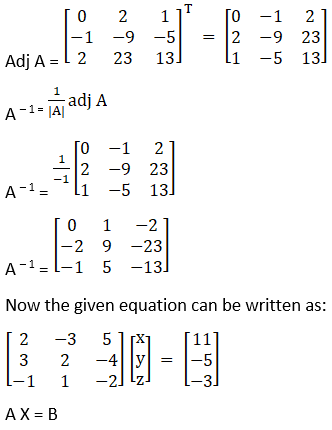
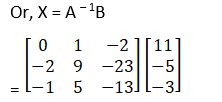
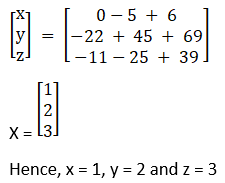

x + 2y + 5z = 10, x – y – z = -2, 2x + 3y – z = -11.
Solution:
Given

|A| = 1(1 + 3) + 2(– 1 + 2) + 5(3 + 2)
= 4 + 2 + 25
= 27
Now, the cofactors of A
C11 = (– 1)1 + 1 1 + 3 = 4
C21 = (– 1)2 + 1 – 2 – 15 = 17
C31 = (– 1)3 + 1 – 2 + 5 = 3
C12 = (– 1)1 + 2 – 1 + 2 = – 1
C22 = (– 1)2 + 1 – 1 – 10 = – 11
C32 = (– 1)3 + 1 – 1 – 5 = 6
C13 = (– 1)1 + 2 3 + 2 = 5
C23 = (– 1)2 + 1 3 – 4 = 1
C33 = (– 1)3 + 1 – 1 – 2 = – 3

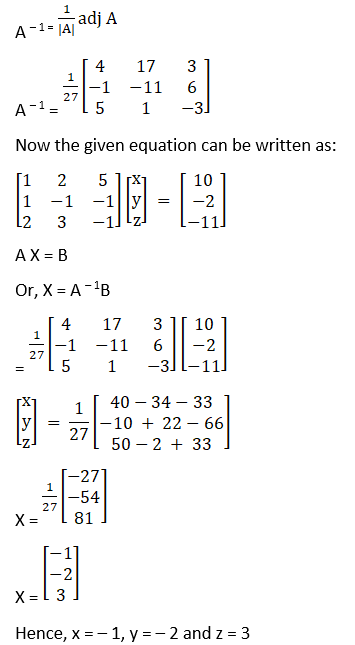

Solution:
Given

|A| = 1(1 + 6) + 2(2 – 0) + 0
= 7 + 4
= 11
Now, the cofactors of A
C11 = (– 1)1 + 1 1 + 6 = 7
C21 = (– 1)2 + 1 – 2 – 0 = 2
C31 = (– 1)3 + 1 – 6 – 0 = – 6
C12 = (– 1)1 + 2 2 – 0 = – 2
C22 = (– 1)2 + 1 1 – 0 = 1
C32 = (– 1)3 + 1 3 – 0 = – 3
C13 = (– 1)1 + 2 – 4 – 0 = – 4
C23 = (– 1)2 + 1 – 2 – 0 = 2
C33 = (– 1)3 + 1 1 + 4 = 5
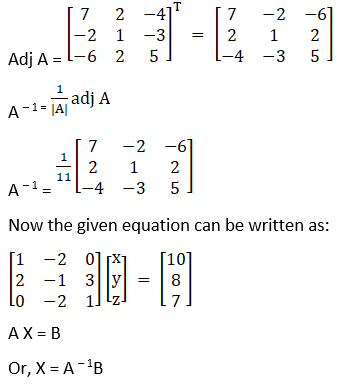
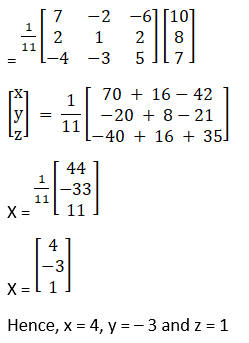

Solution:
Given

|A| = 3(3 – 0) + 4(2 – 5) + 2(0 – 3)
= 9 – 12 – 6
= – 9
Now, the cofactors of A
C11 = (– 1)1 + 1 3 – 0 = 3
C21 = (– 1)2 + 1 – 4 – 0 = 4
C31 = (– 1)3 + 1 – 20 – 6 = – 26
C12 = (– 1)1 + 2 2 – 5 = 3
C22 = (– 1)2 + 1 3 – 2 = 1
C32 = (– 1)3 + 1 15 – 4 = – 11
C13 = (– 1)1 + 2 0 – 3 = – 3
C23 = (– 1)2 + 1 0 + 4 = – 4
C33 = (– 1)3 + 1 9 + 8 = 17
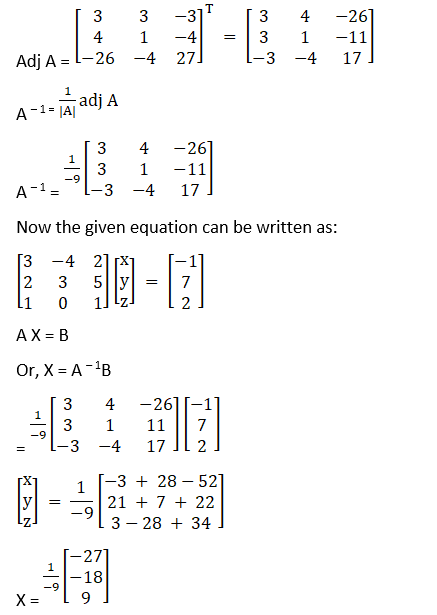
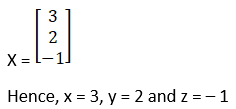

Solution:
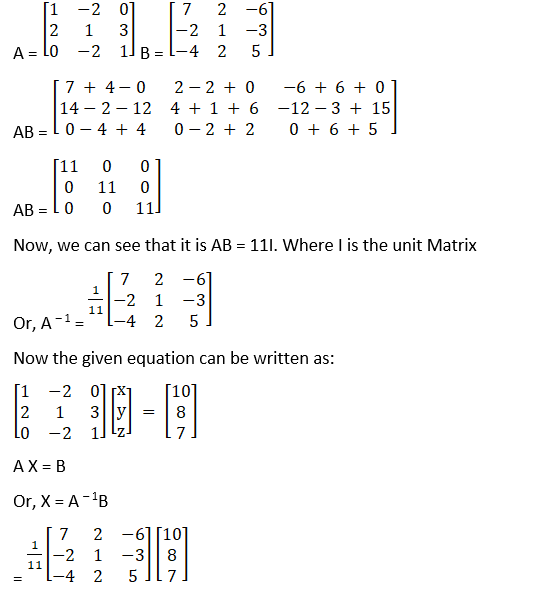

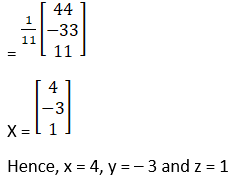

Solution:
Given

|A| = 1(– 1 – 1) – 2(– 2 – 0) + 0
= – 2 + 4
= 2
Now, the cofactors of A
C11 = (– 1)1 + 1 – 1 – 1 = – 2
C21 = (– 1)2 + 1 2 – 0 = 2
C31 = (– 1)3 + 1 – 2 – 0 = – 2
C12 = (– 1)1 + 2 2 – 0 = – 2
C22 = (– 1)2 + 1 1 – 0 = 1
C32 = (– 1)3 + 1 – 1 – 0 = 1
C13 = (– 1)1 + 2 – 2 – 0 = – 2
C23 = (– 1)2 + 1 – 1 – 0 = 1
C33 = (– 1)3 + 1 – 1 + 4 = 3

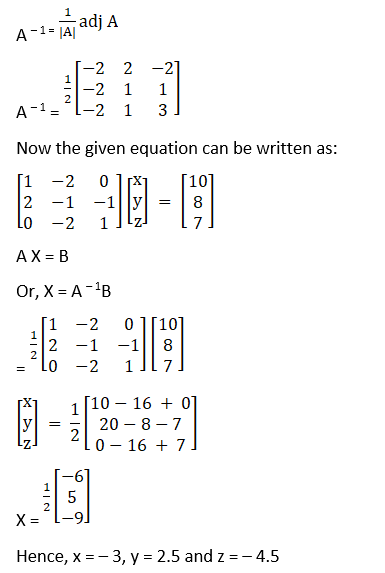

Solution:
Given

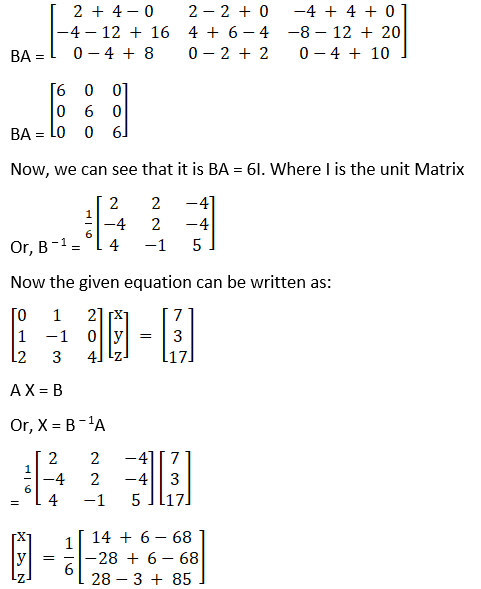
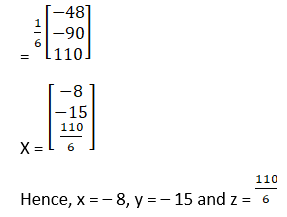
9. The sum of three numbers is 2. If twice the second number is added to the sum of first and third, the sum is 1. By adding second and third number to five times the first number, we get 6. Find the three numbers by using matrices.
Solution:
Let the numbers are x, y, z
Also, 2y + (x + z) + 1
x + 2y + z = 1 …… (ii)
Again,
x + z + 5(x) = 6
5x + y + z = 6 …… (iii)

A X = B
|A| = 1(1) – 1(– 4) + 1(– 9)
= 1 + 4 – 9
= – 4
Hence, the unique solution given by x = A – 1B
C11 = (– 1)1 + 1 (2 – 1) = 1
C12 = (– 1)1 + 2 (1 – 5) = 4
C13 = (– 1)1 + 3 (1 – 10) = – 9
C21 = (– 1)2 + 1 (1 – 1) = 0
C22 = (– 1)2 + 2 (1 – 5) = – 4
C23 = (– 1)2 + 3 (1 – 5) = 4
C31 = (– 1)3 + 1 (1 – 2) = – 1
C32 = (– 1)3 + 2 (1 – 1) = 0
C33 = (– 1)3 + 3 (2 – 1) = 1
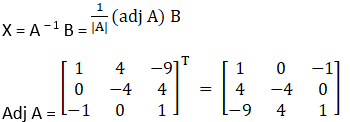
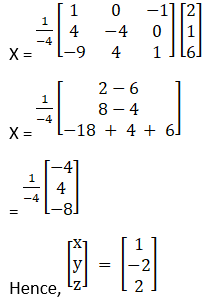
10. An amount of ₹10,000 is put into three investments at the rate of 10, 12 and 15% per annum. The combined incomes are ₹1310 and the combined income of first and second investment is ₹ 190 short of the income from the third. Find the investment in each using matrix method.
Solution:
Let the numbers are x, y, and z
x + y + z = 10,000 …… (i)
Also,
0.1x + 0.12y + 0.15z = 1310 …… (ii)
Again,
0.1x + 0.12y – 0.15z = – 190 …… (iii)

A X = B
|A| = 1(– 0.036) – 1(– 0.03) + 1(0)
= – 0.006
Hence, the unique solution given by x = A – 1B
C11 = – 0.036
C12 = 0.27
C13 = 0
C21 = 0.27
C22 = – 0.25
C23 = – 0.02
C31 = 0.03
C32 = – 0.05
C33 = 0.02
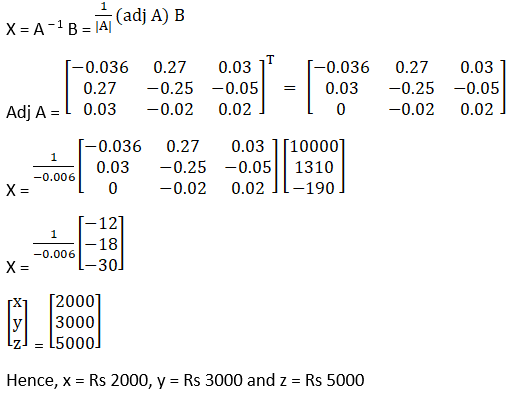
Exercise 8.2 Page No: 8.20
Solve the following systems of homogeneous linear equations by matrix method:
1. 2x – y + z = 0
3x + 2y – z = 0
x + 4y + 3z = 0
Solution:
Given
2x – y + z = 0
3x + 2y – z = 0
X + 4y + 3z = 0
The system can be written as

A X = 0
Now, |A| = 2(6 + 4) + 1(9 + 1) + 1(12 – 2)
|A| = 2(10) + 10 + 10
|A| = 40 ≠ 0
Since, |A|≠ 0, hence x = y = z = 0 is the only solution of this homogeneous equation.
2. 2x – y + 2z = 0
5x + 3y – z = 0
X + 5y – 5z = 0
Solution:
Given 2x – y + 2z = 0
5x + 3y – z = 0
X + 5y – 5z = 0
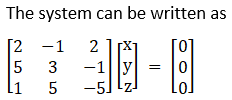
A X = 0
Now, |A| = 2(– 15 + 5) + 1(– 25 + 1) + 2(25 – 3)
|A| = – 20 – 24 + 44
|A| = 0
Hence, the system has infinite solutions
Let z = k
2x – y = – 2k
5x + 3y = k
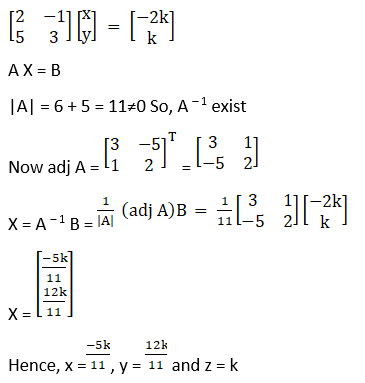
3. 3x – y + 2z = 0
4x + 3y + 3z = 0
5x + 7y + 4z = 0
Solution:
Given 3x – y + 2z = 0
4x + 3y + 3z = 0
5x + 7y + 4z = 0

A X = 0
Now, |A| = 3(12 – 21) + 1(16 – 15) + 2(28 – 15)
|A| = – 27 + 1 + 26
|A| = 0
Hence, the system has infinite solutions
Let z = k
3x – y = – 2k
4x + 3y = – 3k
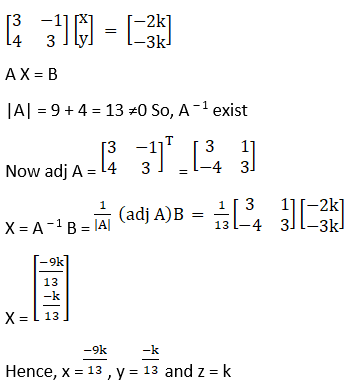
4. x + y – 6z = 0
x – y + 2z = 0
– 3x + y + 2z = 0
Solution:
Given x + y – 6z = 0
x – y + 2z = 0
– 3x + y + 2z = 0
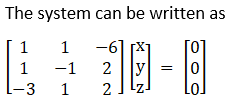
A X = 0
Now, |A| = 1(– 2 – 2) – 1(2 + 6) – 6(1 – 3)
|A| = – 4 – 8 + 12
|A| = 0
Hence, the system has infinite solutions
Let z = k
x + y = 6k
x – y = – 2k
